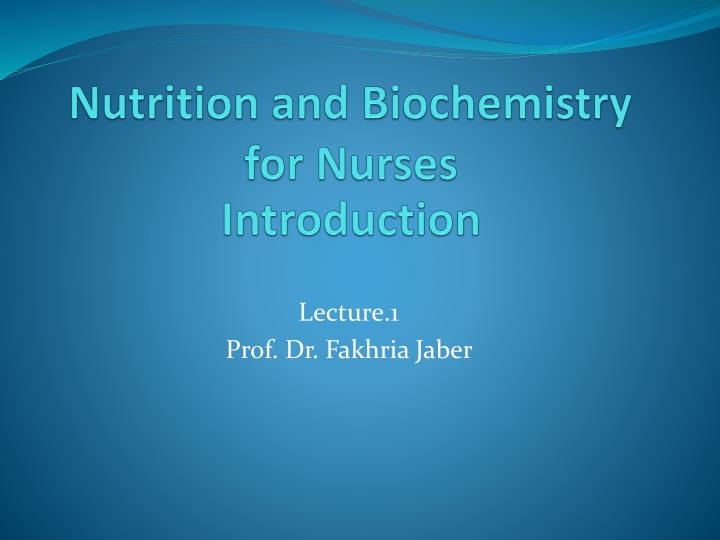
Nutrition: The Key to Health and Wellness
Explore the fundamentals of nutrition, including the study of nutrients in food, the importance of a balanced diet, and the impact of malnutrition. Discover essential nutrients, classes of nutrients, and the role of nutrition in the body's digestion and absorption processes.
Download Presentation

Please find below an Image/Link to download the presentation.
The content on the website is provided AS IS for your information and personal use only. It may not be sold, licensed, or shared on other websites without obtaining consent from the author. If you encounter any issues during the download, it is possible that the publisher has removed the file from their server.
You are allowed to download the files provided on this website for personal or commercial use, subject to the condition that they are used lawfully. All files are the property of their respective owners.
The content on the website is provided AS IS for your information and personal use only. It may not be sold, licensed, or shared on other websites without obtaining consent from the author.
E N D
Presentation Transcript
Lecture.1 Prof. Dr. Fakhria Jaber
Nutrition: is the study of nutrients in food, and how the body uses them, through processes include, digestion, absorption, and metabolism. Food: Is any substance normally eaten or drunk by living human. Food is the main source of energy and nutrition for human
Nutrients: a chemical substance obtained from food and needed by the body for growth, maintenance, or repair of tissues. Diet: - is defined as food containing all the nutrients in a sufficient amount and in proper ratio. Diet may also be modified and used for ill persons as part of their therapy (therapeutic diets).
Malnutrition: - is the imbalance between dietary intake and requirements. It includes under nutrition, which results from less food intake and hard physical work and over nutrition results from excess food intake and less physical activities.
Classes of Nutrient: Essential nutrients include: A-The macronutrients:(carbohydrates, fats, and proteins) it is supply energy and build tissue. B- The micronutrients:(vitamins and minerals) needed in much smaller amounts, form specialized structures and regulate body processes. C-Water: is the additional and often-forgotten nutrient that sustains all life systems.
Use of Nutrition in the body: Digestion: is the process of breaking up food. Absorption: is the process which carries these nutrients into the circulation system and delivers them to the cell. Utilization: Cell is the functional unit of life. chemical reactions in the cell use the nutrients absorbed to produce materials needed for the life.
Digestive system Digestive tract and other organs that help the body break down and absorb food. It is starts from the mouth and end to anus.
Function of each organ of the digestive system in digestion. 1- Mouth : teeth chew food, glands in the cheeks and under the tongue produce saliva that coats the food. Saliva also contains enzymes that start to digest the carbohydrates in food. 2- Oesophagus: is the muscular tube that carries food from the mouth to the stomach after it is swallowed. A ring of muscle at the end of the oesophagus prevent stomach contents from escaping back up the oesophagus.
3- Stomach : stomach wall produces gastric juice that digests proteins. 4- Small intestine: break down protein into amino acids and fat into fatty acids. Sugars, vitamins and minerals, are absorbed into the bloodstream through the wall of the small intestine. Most of the chemical digestion of proteins, fats and carbohydrates is completed in the small intestine.
5- Large intestine and anus: absorbs water, mineral salts and vitamins. Feces are formed and stored in the last part of the large intestine (the rectum) before being passed out of the body through the anus.
General function of nutrition 1. Provide energy (carbohydrate, fat, and protein can be used for energy). 2. Build and repair body tissues and structures (Protein is the primary nutrient for building and maintaining body tissues) 3. Regulate the metabolic processes that maintain homeostasis (water, Specific vitamins and minerals are necessary for enzyme activities responsible for a host of chemical reactions). 4.Regulate activities of the body
Metabolic rate: the rate of heat release during chemical reactions, it is expressed in units called calories. The basal metabolic rate (BMR) : the energy needed to maintain essential physiological functions, such as respiration, circulation, and muscle tone.
Energy Balance The relationship between the energy derived from food and the energy used by the body. The body obtains energy in the form of calories from carbohydrates, protein, and fat. The body uses energy for voluntary activities such as walking and talking and for involuntary activities such as breathing and secreting enzymes.
Factors which Affect Basal Metabolic Rate (BMR) . 1. Body surface area Tall, thin people have higher BMRs If we compare a tall person with a short person of equal weight 2. Sex: Males average a higher BMR because of a greater proportion of lean body mass. 3. Body temperature: Fever, for example, increases BMR.
4. Hormones: Thyroid hormones have a stimulatory effect on the metabolism of the body. Thus BMR is raised in hyperthyroidism and reduced in hypothyroidism. 5. Age: Metabolic rate declines with age. In infants and children BMR is higher and in adults it is less.
6. Diet: Hunger or serious abrupt calorie reduction can dramatically reduce BMR. Restrictive low-calorie weight loss diets may cause BMR to drop. 7. Pregnancy/breast feeding: these increase metabolic rate 8. Environment: In cold climates, the BMR is higher compared to warm climates.
9. Rapid growth and/or development: infancy, growth spurts, healing after illness or injury. 10. Disease states: BMR is higher in cardiac failure, leukemia, and hypertension. 11. Weight. Heavier the weight, the higher BMR. 12. Exercise: Physical exercise not only influences body weight by burning calories, it also helps raise our BMR by building extra-lean tissue.















